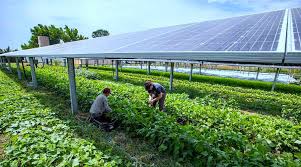Agrivoltaic farming:

The Seventh Session of the International Solar Alliance (ISA) concluded in New Delhi, highlighting sustainable energy and agrivoltaic farming a practice that combines agriculture with solar energy generation on the same land.
- Agrivoltaic farming is the simultaneous use of land for agriculture and solar energy generation, allowing crops to grow beneath solar panels.
- Solar panels are raised 2-3 meters, providing space for crops to grow beneath with adequate light and air.
- Panels are angled and spaced to optimize sunlight for both solar energy and crop growth.
- Panels offer shade, reducing heat stress and protecting crops from harsh weather.
- Shading lowers evaporation, conserving soil moisture and reducing water needs.
- Panels on greenhouse roofs allow light/rain for crops while generating energy.
- Utilizes land for both solar power and agriculture, maximizing energy and food production.
- Agrivoltaic Farming:
- Maximizes land efficiency by combining agriculture and solar energy production on the same land.
- Provides shade to crops, reducing heat stress and water loss, and protecting from extreme weather.
- Contributes to solar power expansion, supporting climate goals and energy needs.
- Supports sustainable food production for a growing population without needing additional land.
- Enables farmers to diversify income through both crop production and solar energy revenue.




